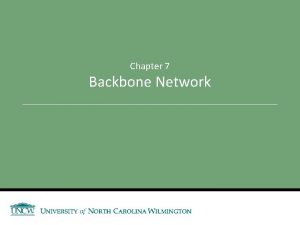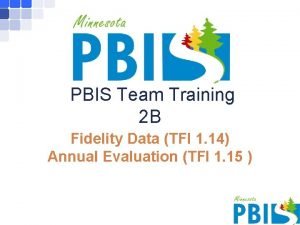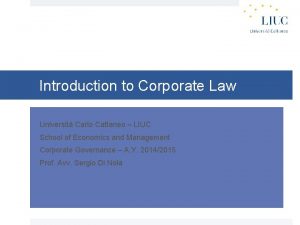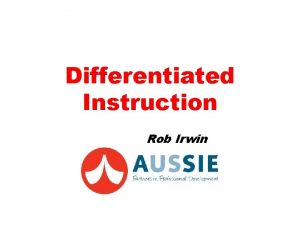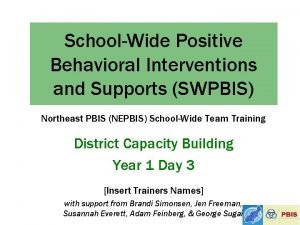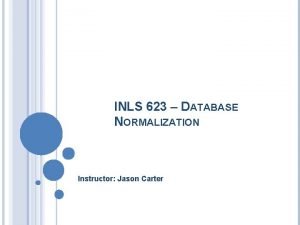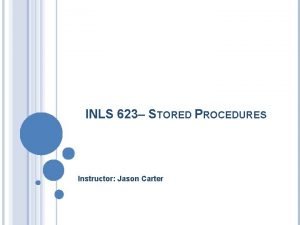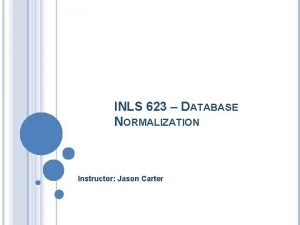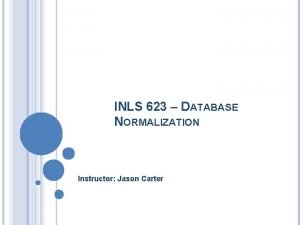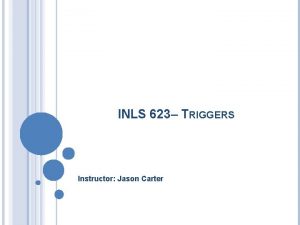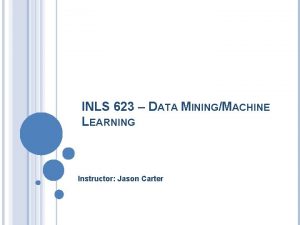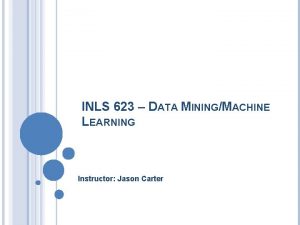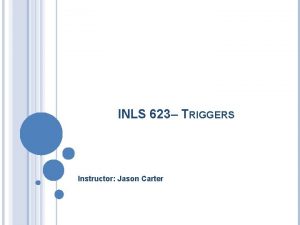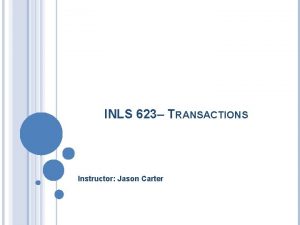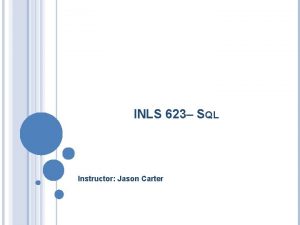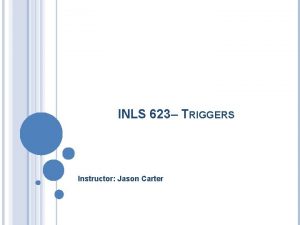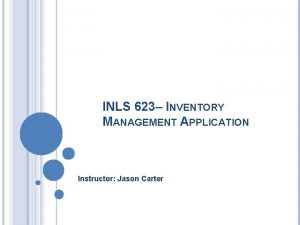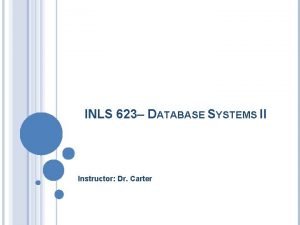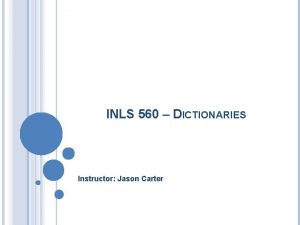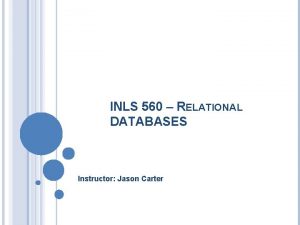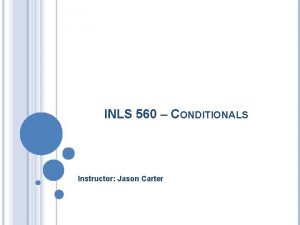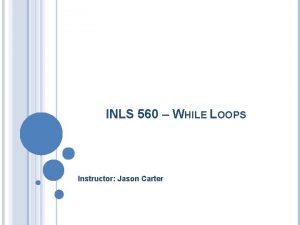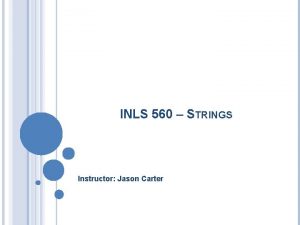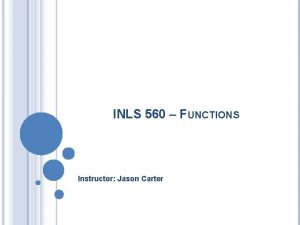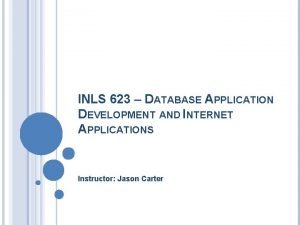INLS 623 THREE TIERED ARCHITECTURES Instructor Jason Carter
































![EXAMPLE while($row = $result->fetch_assoc()) { echo "<tr>"; echo "<td>"; echo $row['customer. Number']; //echo $row['orderdetails. EXAMPLE while($row = $result->fetch_assoc()) { echo "<tr>"; echo "<td>"; echo $row['customer. Number']; //echo $row['orderdetails.](https://slidetodoc.com/presentation_image_h2/e55241edd69e069294402987ff4ed5a1/image-33.jpg)





















- Slides: 54

INLS 623– THREE TIERED ARCHITECTURES Instructor: Jason Carter

REVIEW: INTERNET Server Client HTML Java. Script CSS AJAX Cookies HTTP Request Response GET POST Redirect Java ASP. NET Python PHP SQL

REVIEW: SAMPLE PHP <h 1>Hello from Dr. Chuck's HTML Page</h 1> <p> <? php echo "Hi there. n"; $answer = 6 * 7; echo "The answer is $answer, what "; echo "was the question again? n"; ? > </p> <p>Yes another paragraph. </p>

REVIEW: INTERPRETED LANGUAGES Interpreter reads code and performs operations one line at a time. PHP Interpeter Machine Language

REVIEW: CONNECTING TO MYSQL <? php $servername = "localhost"; $username = "root"; $password = "root"; $dbname = "classicmodels"; // Create connection $conn = new mysqli($servername, $username, $password, $dbname); // Check connection if ($conn->connect_error) { die("Connection failed: ". $conn->connect_error); } ? >

REVIEW: SELECTING FROM A TABLE <? php $servername = "localhost"; $username = "root"; $password = "root"; $dbname = ”classicmodels"; // Create connection $conn = new mysqli($servername, $username, $password, $dbname); // Check connection if ($conn->connect_error) { die("Connection failed: ". $conn->connect_error); $sql = "select * from customers"; $result = $conn->query($sql); } ? >

if ($conn->connect_error) { die("Connection failed: ". $conn->connect_error); $sql = "select * from customers"; $result = $conn->query($sql); //if the number of rows are greater than 0 if ($result->num_rows > 0) { //while there are rows while($row = $result->fetch_assoc()) { echo $row['customer. Number']. " ". $row['customer. Name']. " ". $row['contact. First. Name']. " ". $row['contact. Last. Name']; echo " "; echo " ”; } } } //close the connection mysqli_close($conn); ? >

LIST TABLES <? php $servername = "localhost"; $username = "root"; $password = "root"; $dbname = "classicmodels"; // Create connection $conn = new mysqli($servername, $username, $password, $dbname); // Check connection if ($conn->connect_error) { die("Connection failed: ". $conn->connect_error); } ? >

SELECTING DATA <? php $servername = "localhost"; $username = "root"; $password = "root"; $dbname = ”classicmodels"; // Create connection $conn = new mysqli($servername, $username, $password, $dbname); // Check connection if ($conn->connect_error) { die("Connection failed: ". $conn->connect_error); $sql = ”show tables from $dbname"; $result = $conn->query($sql); } ? >

$conn = new mysqli($servername, $username, $password, $dbname); // Check connection if ($conn->connect_error) { die("Connection failed: ". $conn->connect_error); $sql = "select * from customers"; $result = $conn->query($sql); //if the number of rows are greater than 0 if ($result->num_rows > 0) { //while there are rows while($row = $result->fetch_row()) { echo $row[0]; echo " ”; } } } //close the connection mysqli_close($conn); ? >

<? php INSERTING DATA //variables that will be inserted into the database $number = mt_rand(9000, 1000000); $customer. Number = $number; $customer. Name = "The Little Shop that Could"; $contact. First. Name = "Alex"; $contact. Last. Name = "Becky"; $phone = "55555"; $address. Line 1 = "City that never sleeps"; $address. Line 2 = ""; $city = "Chapel Hill"; $state = "NC"; $postal. Code = "27514"; $country = "US"; $sales. Rep. Employee. Number = 1056; $credit. Limit = 2000. 00; ? >

<? php $sql = "insert into customers values ('$customer. Number', '$customer. Name', '$contact. First. Name', '$contact. Last. Name', '$phone', '$address. Line 1', '$address. Line 2', '$city', '$state', '$postal. Code', '$country', '$sales. Rep. Employee. Number', '$credit. Limit')"; //execute the query result = $conn->query($sql); ? >

<? php if($result) { echo "New record created successfully"; } else { echo "Error: ". $sql. " ". mysqli_error($conn); } mysqli_close($conn); ? >

INSERTING DYNAMIC DATA Use HTML forms to collect data <form> </form> Form tags contain html elements There are many html elements � Input Text Radio submit

INPUT TEXT TAGS <form> First name: <input type="text" name="firstname"> Last name: <input type="text" name="lastname"> </form>

INPUT SUBMIT TAG <form action="action_page. php"> First name: <input type="text" name="firstname" value="Mickey"> Last name: <input type="text" name="lastname" value="Mouse"> <input type="submit" value="Submit"> </form>

SUBMIT Sends the values of the input tag (not the submit button) to the server The action tag determines which file processes the values from the input tag � <form action="action_page. php"> How?

PASS VALUES TO SERVER/PHP GET (default) � form submission is passive (like a search engine query), and without sensitive information � GET is best suited to short amounts of data. Size limitations are set in your browser � action_page. php? firstname=Mickey&lastname=Mouse <form action="action_page. php” method=“GET”>

PASS VALUES TO SERVER/PHP POST � form is updating data, or includes sensitive information (password) � POST offers better security because the submitted data is not visible in the page address <form action="action_page. php" method="POST">

HOW DOES PHP GET THE VALUES? Superglobals � Built in variables that are available at all scopes $GLOBALS $_SERVER $_REQUEST $_POST $_GET $_FILES $_ENV $_COOKIE $_SESSION

PHP $_POST Collects form data after submitting the HTML from using post <form action="action_page. php” method = “POST”> First name: <input type="text" name="firstname" value="Mickey"> Last name: <input type="text" name="lastname" value="Mouse"> <input type="submit" value="Submit"> </form> echo $_POST[‘firstname’]; echo $_POST[‘’lastname’];

PHP $_GET Collects form data after submitting the HTML from using post <form action="action_page. php” method = “GET”> First name: <input type="text" name="firstname" value="Mickey"> Last name: <input type="text" name="lastname" value="Mouse"> <input type="submit" value="Submit"> </form> echo $GET[‘firstname’]; echo $GET[‘’lastname’];

DISPLAY ORDERS Look at file display. Orders. php

PRACTICE Create an html form that allows a user to search for a customer by state

PRACTICE Create an html form that allows a user to enter information into the employee table

PRACTICE Create an html form that allows a user to enter a quantity in stock and see all products that are below that quantity Create an html form that allows a user to enter a quantity in stock and see all products that are above that quantity

THREE TIERED ARCHITECTURES Presentation tier Middle tier Data management tier Client Program (Web Browser) Application Server Database System

THE THREE LAYERS Presentation tier � Primary interface to the user � Needs to adapt different displays (PC, cell, tablet, etc) Middle tier Implements business logic (implements complex actions, maintains state between different steps of workflow) � Access different data management systems � Data management tier � One or more standard database management system

TECHNOLOGIES HTML Javascript PHP Cookies XML Stored Procedures Functions Client Program (Web Browser) Application Server (Apache) Database System (My. SQL)

ADVANTAGES OF THE THREE-TIER ARCHITECTURE Heterogeneous � Tiers can be independently maintained, modified, and replaced Scalability � Data Management Tier can be scaled by database clustering without involving other tiers � Middle Tier can be scaled by using load balancing Fault Tolerance � Data Management Tier can be replicated without involving other tiers Software development � Code is centralized � Interaction between tiers through well-defined APIs: Can reuse standard components at each tier

DISADVANTAGES OF 3 -TIER ARCHITECTURE It is more complex It is more difficult to build a 3 -tier application The physical separation of the tiers may affect the performance of all three � If hardware and network bandwidth are not good enough because more networks, computers, and processes are involved

EXAMPLE edit. Table. php The presentation tier (html) and middle tier (php) are together
![EXAMPLE whilerow resultfetchassoc echo tr echo td echo rowcustomer Number echo roworderdetails EXAMPLE while($row = $result->fetch_assoc()) { echo "<tr>"; echo "<td>"; echo $row['customer. Number']; //echo $row['orderdetails.](https://slidetodoc.com/presentation_image_h2/e55241edd69e069294402987ff4ed5a1/image-33.jpg)
EXAMPLE while($row = $result->fetch_assoc()) { echo "<tr>"; echo "<td>"; echo $row['customer. Number']; //echo $row['orderdetails. order. Number']; echo "</td>"; echo "<td>"; echo $row['check. Number']; echo "</td>"; echo "<td>"; echo $row['payment. Date']; echo "</td>"; echo "<td>"; echo "$". $row['amount']; echo "</td>";

HTML TEMPLATES Provides place holders in html that are filled with values from PHP Done using some kind if template engine

HTML TEMPLATES

PHP TEMPLATES HTML My. SQL PHP HTML

XML AND XLST HTML My. SQL PHP XML XLST HTML

XML AND XLST XML = e. Xtensible Markup Language � XML is much like HTML � Designed to describe data, not to display it � XML tags are not predefined. Must define your own tags.

DIFFERENCE BETWEEN XML AND HTML XML is not a replacement for HTML. XML and HTML were designed with different goals: � XML was designed to describe data, with focus on what data is � HTML was designed to display data, with focus on how data looks � HTML is about displaying information, while XML is about carrying information

XML ELEMENTS An XML document contains XML Elements XML Element � everything from (including) the element's start tag to (including) the element's end tag <all. Payments> <payment> <customer. Number>103</customer. Number> <check. Number>155</check. Number> <payment. Date>10 -23 -2014</payment. Date> <amount>$55. 53</amount> <payment> </all. Payments>

XML NAMING RULES XML elements must follow these naming rules: � Names can contain letters, numbers, and other characters � Names cannot start with a number or punctuation character � Names cannot start with the letters xml (or XML, or Xml, etc) � Names cannot contain spaces Any name can be used, no words are reserved. Please be descriptive.

XML SYNTAX All XML elements must have a closing tag <message>hi how are you</message> (correct) <message>hi how are you (incorrect) XML Tags are case sensitive Opening and closing tags must be written in the same case � <message>hi how are you</message> (correct) � <Message>hi how are you</message> (incorrect) � XML tags must have a root <root> <child> <subchild>. . . </subchild> </root>

PRACTICE Create XML for the product. Lines table <all. Product. Lines> <product. Line></product. Line> <text. Description></text. Description> <html. Description></html. Description> <image></image> </product. Lines> </all. Product. Lines>

XLST XSLT = EXtensible Stylesheet Language Transformations Transforms xml document into html

TRANSFORMING XML USING XLST Start with an XML Document <? xml version="1. 0" encoding="UTF-8"? > <catalog> <cd> <title>Empire Burlesque</title> <artist>Bob Dylan</artist> <country>USA</country> <company>Columbia</company> <price>10. 90</price> <year>1985</year> </cd> </catalog>

TRANSFORMING XML USING XLST Create an xlst stylesheet

<? xml version="1. 0" encoding="UTF-8"? > <xsl: stylesheet version="1. 0" xmlns: xsl="http: //www. w 3. org/1999/XSL/Transform"> <xsl: template match="/"> <html> <body> <h 2>My CD Collection</h 2> <table border="1"> <tr bgcolor="#9 acd 32"> <th>Title</th> <th>Artist</th> </tr> <xsl: for-each select="catalog/cd"> <tr> <td><xsl: value-of select="title"/></td> <td><xsl: value-of select="artist"/></td> </tr> </xsl: for-each> </table> </body> </html> </xsl: template> </xsl: stylesheet>

TRANSFORMING XML USING XLST Link the XSL Style Sheet to the XML Document <? xml version="1. 0" encoding="UTF-8"? > <? xml-stylesheet type="text/xsl" href="cdcatalog. xsl"? > <catalog> <cd> <title>Empire Burlesque</title> <artist>Bob Dylan</artist> <country>USA</country> <company>Columbia</company> <price>10. 90</price> <year>1985</year> </cd> </catalog>

HOW DOES THIS WORK IN PHP edit. Table. xml. php

SMARTY TEMPLATES A template engine for PHP, facilitating the separation of presentation (HTML/CSS) from application logic.

PHP FRAMEWORKS Streamline the development of web applications written in PHP by providing a basic structure for which to build the web applications � Saves time � Helps build more stable applications � Reduces amount of repetitive coding Force you to follow a pattern

PHP FRAMEWORKS The Zend Framework Cake. PHP Symfony Code. Igniter

HOMEWORK Explain the advantages and disadvantages of a three tiered architecture. Use XML and XLST to design a three tiered architecture for the classicmodels database. Create an html form that allows a user to search for customers by state. The user should be able to enter a state in a textbox and a list of customers in a table are shown. � Create an html form that allows a user to enter a quantity in stock and see all products that are below that quantity. The user should enter the quantity in a textbox and a list of products in a table are shown. � Create an html form that allows a user to enter a quantity in stock and see all products that are above that quantity. � The user should enter the quantity in a textbox and a list of products in a table are shown. �

HOMEWORK Research Question � Compare and contrast two PHP frameworks. You can use the ones mentioned in the lecture or search for others.
 Inls 161
Inls 161 Database system architectures
Database system architectures Database storage architecture
Database storage architecture Banking system architecture diagram
Banking system architecture diagram Types of instruction sets
Types of instruction sets Scalable internet architectures
Scalable internet architectures Cdn architectures
Cdn architectures Ansi/sparc
Ansi/sparc Backbone network architectures
Backbone network architectures Architecture of e-commerce
Architecture of e-commerce Integral vs modular architecture
Integral vs modular architecture Scalable web architectures
Scalable web architectures Backbone network architectures
Backbone network architectures Cache coherence for gpu architectures
Cache coherence for gpu architectures Gui architectures
Gui architectures Slot modular architecture examples
Slot modular architecture examples Explain the three tier architecture of data warehouse
Explain the three tier architecture of data warehouse Autoencoders, unsupervised learning, and deep architectures
Autoencoders, unsupervised learning, and deep architectures Why systolic architectures
Why systolic architectures Bfidelity
Bfidelity What are the 3 tiers of pbis
What are the 3 tiers of pbis Tiered reference service
Tiered reference service Nimble page management for tiered memory systems
Nimble page management for tiered memory systems Geofoam applications
Geofoam applications Two tiered board structure
Two tiered board structure Tiers of academic vocabulary
Tiers of academic vocabulary Improving hr service delivery
Improving hr service delivery Tiered fidelity inventory
Tiered fidelity inventory Dynamics 365 tiered pricing
Dynamics 365 tiered pricing Pin name
Pin name Two tiered board structure
Two tiered board structure Tiered task bias task
Tiered task bias task Vocabulary pyramid
Vocabulary pyramid Multi tiered system of supports
Multi tiered system of supports Tiered assignments examples
Tiered assignments examples G team
G team Tricker
Tricker Tiered words
Tiered words Tiering assignments
Tiering assignments Swpbis tiered fidelity inventory
Swpbis tiered fidelity inventory Tiered fidelity inventory worksheet
Tiered fidelity inventory worksheet Bco 623
Bco 623 Da pam 623
Da pam 623 Da pam 623-3
Da pam 623-3 Ncoer regulation ar 623-205
Ncoer regulation ar 623-205 Ncoer ar
Ncoer ar Ncoer form 2166-9-1
Ncoer form 2166-9-1 Ncoer non rated codes
Ncoer non rated codes Gravis carter
Gravis carter Urban realms model
Urban realms model Victor carter-bey
Victor carter-bey Carter mecher md
Carter mecher md Jane carter labor economist
Jane carter labor economist Kafka franz
Kafka franz Rebecca carter skilling
Rebecca carter skilling








